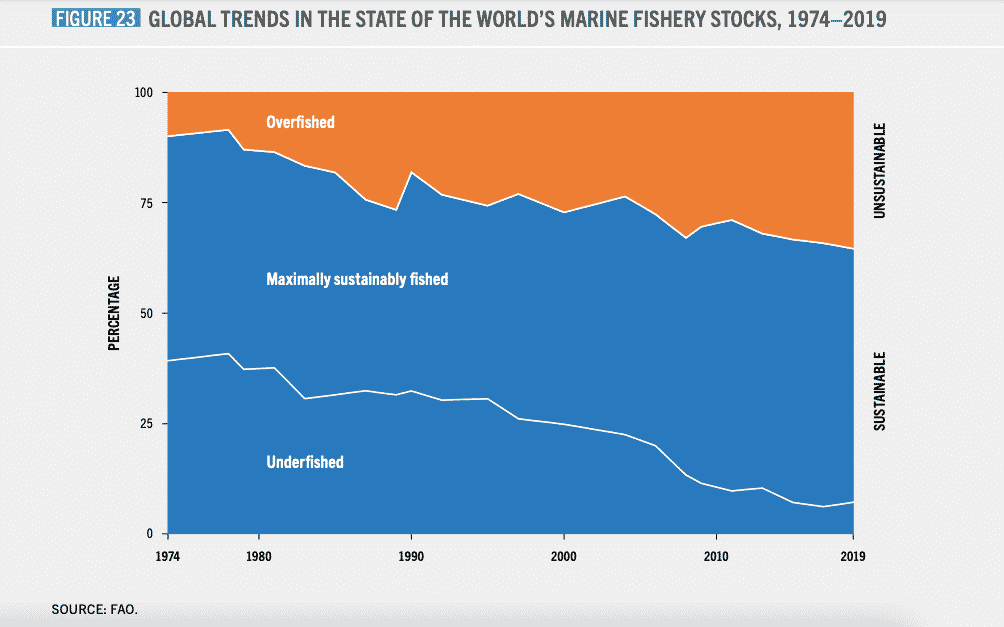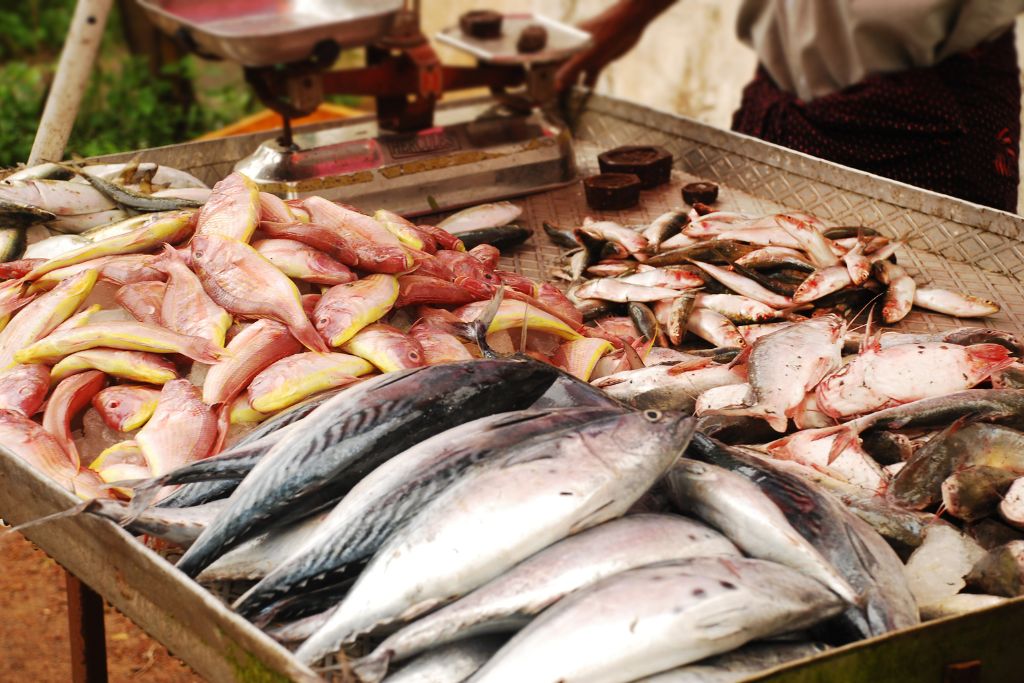The average person eats nearly double the amount of seafood as half a century ago. To satisfy the rapidly growing demand, global production of fish has quadrupled over the past 50 years. This, however, has come with alarming exploitation rates on fish stocks across the world and unsustainable levels of wild fish catch, making overfishing one of the biggest environmental problems of our lifetime. As we reflect on this practice’s detrimental effects, we explore the most effective solutions to overfishing.
—
What Is Overfishing?
Overfishing is, in some sense, a rational reaction to increasing market needs for fish. Since the 1960s, the world’s population has nearly quadrupled. With it came a revolution in lifestyle and food habits.
Nowadays, people consume more than twice as much seafood as they did 50 years ago, with per capita aquatic food consumption growing from an average 9.9 kilograms to a staggering 20.2 kilograms in 2020.
The fish market is now valued at US$406 billion and global fisheries and aquaculture production has reached an all-time high of 214 million metric tons in 2020 – according to the UN State of World Fisheries and Aquaculture Report 2022.
Unsurprisingly, the rising demand for seafood resulted in a steady decline in fishery resources due to overfishing, pollution, poor management, and other factors. Today, less than 65% of stocks are considered to be fished within biologically sustainable levels, with the remaining part being classified as “overfished”. This means that the stock of available fishing waters is being depleted faster than it can be replaced. The report also categorises more than 57% of all stocks as “maximally sustainably fished” and only 7% of stocks as “underfished.”

On a better note, the UN’s flagship report found a slight improvement in the number of landings from biologically sustainable stocks, which experienced a slight decrease from 2017, currently sitting at 64.6%.
While this data suggests that effective fisheries management has been proven successful in rebuilding stocks and increasing catches within ecosystem boundaries, the road to restoring ecosystems to a healthy and productive state while protecting the long-term supply of marine foods is still long.
We explore some of the best and most effective solutions to overfishing.
You might also like: 15 Facts About Overfishing
Solutions to Overfishing
1. Ban Fishing Subsidies
Subsidies for fuel, fishing gear, and building new vessels notoriously incentivise overfishing and represent thus a huge problem. They often benefit large-scale fishing companies which indirectly encourage the use of fuel-intensive fishing and destructive fishing practices such as deep-sea trawling. Furthermore, researchers found that illegal, unreported and unregulated (IUU) fishing is sometimes related to more serious problems like human trafficking and slavery at sea.
In June 2022, the World Trade Organization (WTO) secured a historic deal aimed at curbing fishing subsidies and reducing global overfishing. The landmark Fisheries Agreement introduces new rules to help preserve the world’s oceans, boost falling fishing stocks, and protect the countless communities around the world whose livelihoods depend on marine resources. The accord will see countries working together to ban subsidies to IUU fishing and restrict subsidies for stocks that are already overfished. The text allows for subsidies as long as they are implemented to rebuild the fishing stock to a “biologically sustainable level” and it includes measures to enhance transparency and accountability of governments on how they subsidise the industry.
2. Adopt Rights-Based Fishery Management
A much needed solution to overfishing is the adoption of rights-based fishery management tools. According to the World Wildlife (WWF), such approach can transform global fisheries performance and help achieve a balance between economic, ecological, and social needs around the world. In short, rights-based management (RBM) entitles an entity – such as a person, community, company, or fishing vessel – to fish in a particular place at a particular time. While guaranteeing such entities a certain portion of the catch, they are also required to adhere to certain limits, which range from a limit on how much fish they can catch to specific timeframes and seasons in which fishing is allowed.
One of the most effective policies to reduce overfishing are catch-share programmes, which give out harvest allowances to individuals or companies. These not only help incentivise smarter and timelier fishing rather than a race to catch as much as stock possible but they also promote a healthy balance between the needs of people, the ocean, and the economy and can guarantee healthier fish populations.
3. Apply Regulations on Fishing Nets
By-catching refers to the event of unwanted marine animal species being caught in fisher’s nets as a byproduct, a practice that has increased tremendously since overfishing became such a huge issue. The gigantic nets trawled around the world’s oceans everyday catch thousands of untargeted marine species, including sea turtles, birds and sharks.
To tackle this issue, the Food and Agriculture Organization (FAO) implemented a simple solution: placing the top end of the nets two meters lower, a move that has been shown to effectively reduce the mortality of marine mammal bycatch by 98% in places like the Indian Ocean. This and other regulations aimed at preventing or discouraging by-catch will help keep the environments that fishers work in healthy.
4. Protect Essential Predator Species
Sharks and tuna are some of the marine animal species most prone to overfishing. Labeled as essential predators, these animals lay a vital role in maintaining local ecosystems. Without them, issues such as overpopulation, algal bloom, and other serious environmental problems would arise. For this reason, one of the best solutions to overfishing is promoting programmes and policies that protect these vulnerable species from being caught by fishing vessels. 90% of blue sharks, for example, are mistakenly caught by fishers every year despite not being commercially valuable. It is estimated that one-third of shark species face extinction because of overfishing, bycatch, pollution, and habitat loss.
The FAO has successfully launched a programme to protect threatened deep-sea marine life by supporting new assessment protocols in designated areas before any fishing activities can begin.
You might also like: Shark Liver Oil: The Beauty Industry’s Secret Ingredient
5. Increase Marine Protected Areas and Enhance Controls
Based on current UN estimates, there are more than 15,000 Marine Protected Areas (MPAs) in the world, comprising approximately 27 million square kilometres (almost 10.6 million square miles) – or nearly 7.5% of the ocean, an area the size of North America. In such areas, tight regulations restrict or often prohibit commercial fishing and other potentially harmful activities altogether.
However, experts believe that governments around the world should put more effort in expanding MPAs – given that 92% of the world’s oceans are still unprotected. This is arguably one of the most effective solutions to overfishing and could contribute greatly to meeting the IUCN recommendation of protecting at least 30% of the ocean by 2030.
6. Require Traceability Standards
Among the best solutions to overfishing is also the introduction of traceability standards. As it was highlighted in the 2022 State of World Fisheries and Aquaculture Report, traceability systems represent a crucial effort toward transparent and responsible value chains. Having such standards in place would “allow a product to be followed from its origin to the end market, informing about compliance with many fisheries regulations as well as food safety and certification requirements.”
Traceability standards have been ensured in the past through the adoption of so-called catch documentation schemes (CDS), issuing certificates and trade documents validated by trustworthy national authorities to establish whether a product has been legally sourced, and certifying that the catch was sourced in compliance with all applicable requirements. FAO has been constantly working to support national authorities in understanding and implementing these schemes.
You might also like: WTO Bans Fishing Subsidies in Historic Deal to Reduce Global Overfishing
7. Impose A Ban on Fishing in International Waters
According to Our World In Data, 99% of international waters that do not belong to any single country – also called ‘high seas’ – are unprotected. Given the effectiveness of protected waters in saving fish population and the current lack of regulation of fishing in international waters, introducing a ban on fishing in open seas would likely be an extremely effective overfishing solution.

In 2017, nine nations including Japan, China, and South Korea as well as the European Union agreed on a historic deal to place the central Arctic Ocean (CAO) – an area of nearly 3 million square kilometres (1.2 million square miles) – off-limits to commercial fishers for at least the next 16 years. Moreover, the FAO launched the Common Oceans Program, a plan to regulate fishing in areas beyond national jurisdiction (ABNJ), which comprise 40% of the planet’s surface. The programme successfully reduced tuna overfishing and banned fishing from critically vulnerable areas.
This story is funded by readers like you
Our non-profit newsroom provides climate coverage free of charge and advertising. Your one-off or monthly donations play a crucial role in supporting our operations, expanding our reach, and maintaining our editorial independence.
About EO | Mission Statement | Impact & Reach | Write for us


















